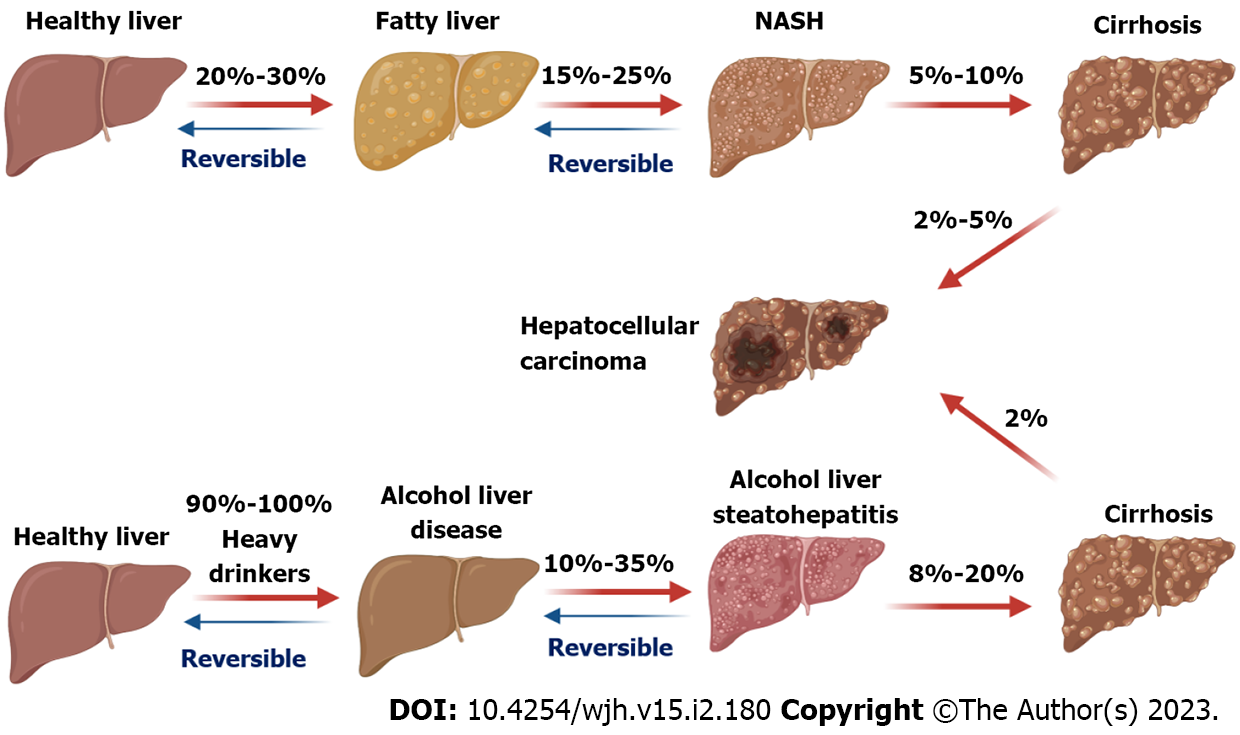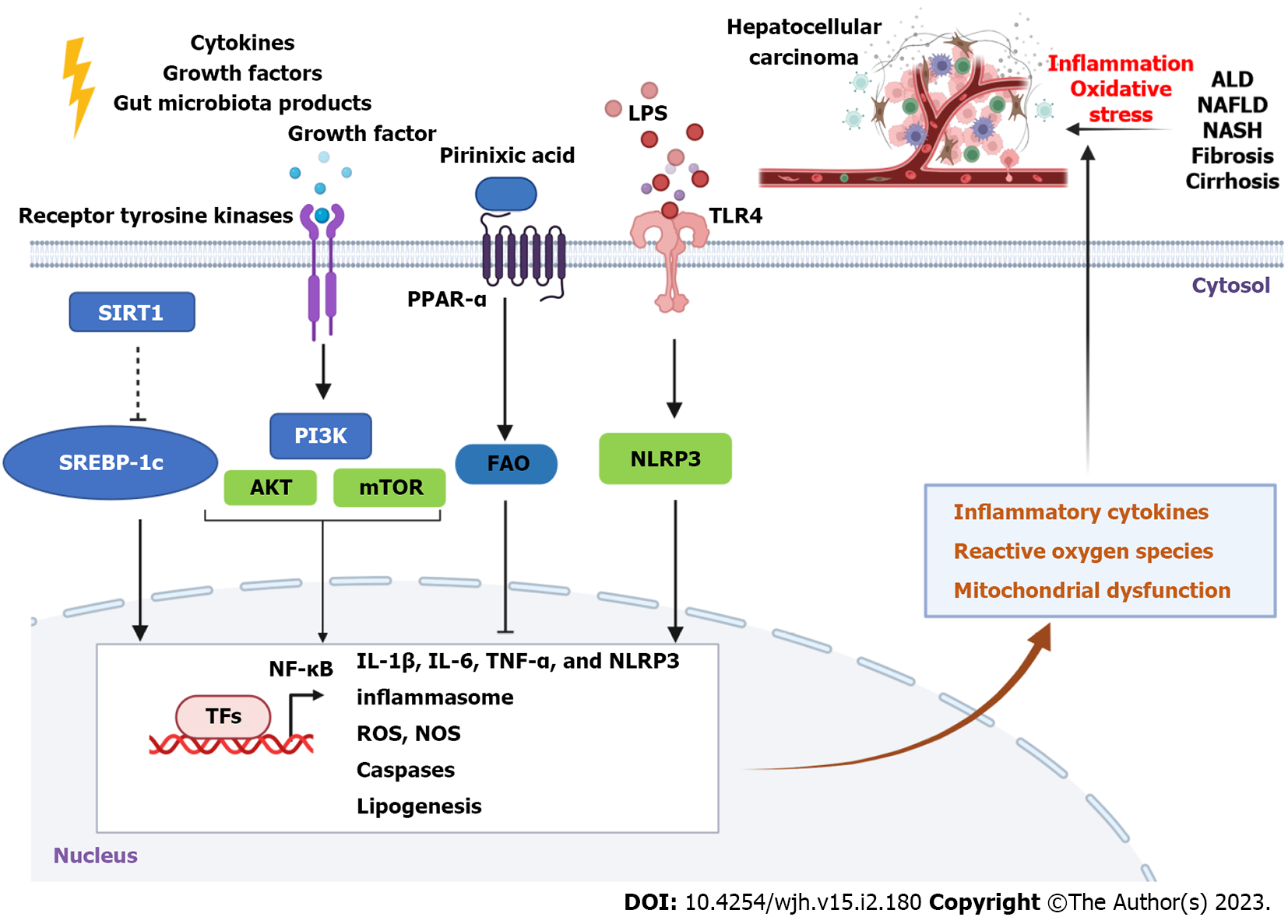Copyright
©The Author(s) 2023.
World J Hepatol. Feb 27, 2023; 15(2): 180-200
Published online Feb 27, 2023. doi: 10.4254/wjh.v15.i2.180
Published online Feb 27, 2023. doi: 10.4254/wjh.v15.i2.180
Figure 1 The development of hepatocellular carcinoma from non-alcoholic fatty liver disease and alcoholic fatty liver disease.
The prevalence (20%-30%) of non-alcoholic fatty liver (NAFL) in the world population and the following percentages of NAFL into non-alcoholic steatohepatitis (NASH) (15%-25%), NASH into cirrhosis (5%-10%), and cirrhosis into hepatocellular carcinoma (HCC) (2%-5%) are labeled. Around 90%-100% of heavy drinkers can develop alcoholic liver disease (ALD), then the percentages of progression from simple ALD into alcohol liver steatohepatitis (10%-35%), cirrhosis (8%-20%), and HCC (2%) are shown in the graphic. This cartoon was created using Biorender online tools (https://biorender.com). NASH: Non-alcoholic steatohepatitis.
Figure 2 Molecular signaling pathway in liver inflammation and oxidative stress.
Inflammation and oxidative stress are involved in the development of chronic liver diseases such as alcoholic liver disease, non-alcoholic fatty liver disease, non-alcoholic steatohepatitis, fibrosis, and cirrhosis into hepatocellular carcinoma. Many factors including cytokines, growth factors, and gut microbiota-derived products such as lipopolysaccharide can activate their receptors such as peroxisome proliferator-activated receptor-α and toll-like receptor 4, resulting in upregulation or inhibition of downstream genes to induce or prevent inflammatory cytokines and production of reactive oxygen species. This cartoon was created using Biorender online tools (https://biorender.com). LPS: Lipopolysaccharide; TLR4: Toll-like receptor 4; ALD: Alcoholic liver disease; NAFLD: Non-alcoholic fatty liver disease; NASH: Non-alcoholic steatohepatitis; PPAR-α: Peroxisome proliferator-activated receptor-α; SIRT1: Sirtuin 1; SREBP-1c: Sterol regulatory element binding protein 1c; PI3K: Phosphatidylinositol-3-kinase; AKT: Protein kinase B; mTOR: Mammalian target of rapamycin; FAO: Fatty acid oxidation; NLRP3: NOD-like receptor family pyrin domain containing 3; NF-κB: Nuclear factor kappa B; IL: Interleukin; TNF-α: Tumor necrosis factor-α; NLRP3: NOD-like receptor family pyrin domain containing 3; ROS: Reactive oxygen species; NOS: Nitric oxide synthase.
Figure 3 Structures of peroxisome proliferator-activated receptor agonists or modulators applied for the treatment of chronic liver disease.
Many peroxisome proliferator-activated receptor regulators have been evaluated in the clinic, showing promising effects in patients with chronic liver disease. All the chemical structures were collected online from the Chemical Book (https://www.chemicalbook.com, accessed on August 10, 2022). PPAR: Peroxisome proliferator-activated receptor.
- Citation: Zhang CY, Liu S, Yang M. Antioxidant and anti-inflammatory agents in chronic liver diseases: Molecular mechanisms and therapy. World J Hepatol 2023; 15(2): 180-200
- URL: https://www.wjgnet.com/1948-5182/full/v15/i2/180.htm
- DOI: https://dx.doi.org/10.4254/wjh.v15.i2.180











